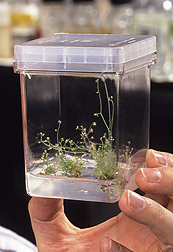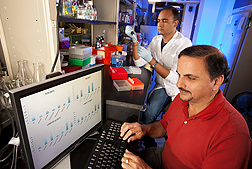Understanding Signals and Controlling Growth in Plants
|
|
Imagine being able to slow down or speed up the growth rate of a crop, manipulate when it flowers, or extend its lifespan. An Agricultural Research Service scientist and his Canadian colleague have found a new signaling mechanism in plants that may allow them to do just that.
Autar Mattoo of the ARS Sustainable Agricultural Systems Laboratory in Beltsville, Maryland, Raju Datla of the Canadian Research Council, and collaborators are analyzing the cellular machinery that controls the growth rate, longevity, nutrition uptake, and metabolism of experimental plants via the “TOR signaling” pathway. Potential long-term applications of this research may include crops with early maturation and shorter growing seasons, ornamentals that last longer, and trees with more desirable growth and fruiting patterns.
Key Signaling Pathway Revealed
TOR-mediated signaling has been widely studied in yeast, animals, and humans. The TOR (target of rapamycin) pathway is a nutrition-and-energy sensor that plays a major role in mediating the signals that control growth, development, and lifespan in these diverse systems. TOR-mediated signals couple energy and nutrient availability with the protein-synthesizing machinery of the cell, the ribosome. Rapamycin, an immunosuppressant drug first discovered as an antifungal compound, shuts down the TOR pathway, thereby slowing growth and development.
Previous work showed that in yeast, mice, and humans, rapamycin functions by binding to a protein known as “FKBP12” (FK506 binding protein 12). But rapamycin doesn’t bind effectively to FKBP12-related proteins in the model plant Arabidopsis or in crop plants, possibly because of differences in the protein structure.
“The question was: Could plants be engineered to respond to rapamycin, thus enabling researchers to analyze TOR pathway functions in plants?” Datla says.
To address this question, the team developed transgenic Arabidopsis plants that produced the yeast version of the FKBP12 protein and selected lines for treatment with rapamycin to monitor the plants’ responses at the growth, developmental, metabolic, and gene-expression levels. As anticipated, the plants containing the yeast FKBP12gene responded to rapamycin by growing more slowly, producing shorter roots and shoots, and living longer than their normal counterparts. For example, leaves on transgenic plants were still green and growing 70 days after seed germination, whereas nonengineered plants had completed their life cycle and senesced.
Rapamycin treatments also affected gene expression, turning off or “down-regulating” genes associated with photosynthesis and cell growth. Consequently, rapamycin-treated transgenic plants failed to respond to increased light and displayed growth rates 10 times slower than those of nonengineered plants when lighting was intensified. Rapamycin treatment also altered the plant’s metabolism—how it processed amino acids, organic acids, polyamines, carbon, and nitrogen.
TOR Linked to a Critical Player in Plant Growth
Previous research suggests that RPS6, a key component of the protein-synthesizing machinery in the cell, plays an important role in plant growth. This protein is known to regulate cell size, growth, and lifespan, so the researchers wanted to investigate its role in TOR signaling. They silenced the gene that expresses the RPS6 protein and observed effects that were similar to those of treating transgenic plants with rapamycin: smaller leaves, shorter roots, delayed flowering, and longer lifespans. The mutant plants also showed the same response to light and nutrition deficiencies as the transgenic plants treated with rapamycin.
In other experiments, they crossed the transgenic Arabidopsis lines with lines in which the RPS6 protein gene was silenced. They found that the protein had to be functioning for rapamycin to shut down the TOR pathway and have its full effect, slowing down growth and development.
Thus, “For TOR inhibition to manifest fully, the plant needs functioning RPS6 genes,” Datla says. The results are described in a paper in the December 2012 issue of The Plant Cell.
Regulatory Implications
While a transgenic crop or agricultural product is likely decades away, and would require regulatory approval, the implications of the researchers’ discovery are intriguing. The study focused on slowing down plant development, delaying flowering, and extending lifespan. But the researchers say the work shows that by manipulating either the TOR pathway or the gene responsible for expressing the RPS6 protein, these processes could also be accelerated.
“These results may enable researchers to develop new strategies for accelerating plant growth, causing early flowering, and extending or reducing the lifespan of an engineered crop,” Mattoo says.—By Dennis O'Brien, Agricultural Research Service Information Staff.
This research is part of Plant Genetic Resources, Genomics, and Genetic Improvement, an ARS national program (#301) described at www.nps.ars.usda.gov.
Autar Mattoo is with the Sustainable Agricultural Systems Laboratory, 10300 Baltimore Ave., Building 001, Beltsville, MD 20705-2350; (301) 504-6622.
"Understanding Signals and Controlling Growth in Plants" was published in the October 2013 issue of Agricultural Research magazine.








